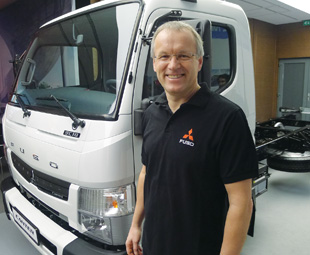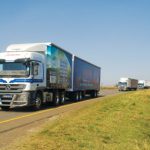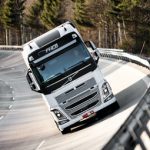Canter is Ecofficiency

JARLATH SWEENEY went to the outskirts of Lisbon, Portugal, to get the details on the latest Euro-6 edition of Daimler’s best selling truck.
Ecofficiency … Now there is a new word that may enter the Oxford Dictionary of English someday soon, as it describes the new Fuso Canter “as even more efficient and even cleaner” than the outgoing model. The new Canter is more efficient in that it is now more productive with the addition of the 8,55-t version as the range topper. The new Canter is also cleaner with the introduction of Euro-6 engine emission controls, which are also fitted to the acclaimed EcoHybrid versions.
Other modifications made to the Canter to qualify for Ecofficiency status include: increasing the injection pressures on the three-litre diesel engines to 2 000 bar (+25 percent), extending axle ratios and introducing Electronic Stability Programme [ESP] as standard, using low-friction engine oils, installing stop/start for the drivetrain and using low-rolling-resistance tyres. The result is that it is up to nine percent more economical than the outgoing model, while at the same time, reducing CO2 emissions by a similar amount.
The development of the 8,55-t Canter is interesting, particularly because it has the potential to carry a six-tonne payload – better than some 12-t rigids with box body and tail-lift.
Its added advantage is the cost benefit from a lower purchase price and reduced running costs. It’s easier to manoeuvre too! Previously the Canter range began at 3,5 t and ended at 7,5 t gross vehicle weight (GVW). With the introduction of the designated 9C15 and 9C18 models, with 150 and 180 hp, respectively, the 8,55 t models will appeal to a broader range of customers in a variety of fields.
The largest Canter has a Duonic automated dual-clutch transmission fitted as standard with the three-litre engines (supplied by Fiat Powertrain Technologies) using Selective Catalytic Reduction (SCR) BlueTec-6 technology with a particulate filter.
Three wheelbases are on offer; from 3,4 to 4,75 m, with maximum body length allowable at 7,21 m. Maximum payload is exactly 5 995 kg, supported by a new 850 mm wide chassis frame, heavier-duty transmission and higher brake/pedal ratio.
As with the previous Canter, there is a Euro-5 engine for the light versions up to six tonnes, but modified to meet new European Union regulations. Termed Euro 5b+, here the exhaust gases are further cleaned by a combination of Exhaust Gas Recirculation (EGR), oxidation catalytic converter and particulate filter.
Euro 6 adds about 30 kg of extra weight to the Canter, as the engine and radiators are slightly heavier. The particulate filter on all models needs no maintenance and does not need to be cleaned as this is done automatically.
Euro-6 technology has also added value to the EcoHybrid version – the first mass-produced parallel diesel/electric system that is cost effective. In achieving up to 23-percent fuel savings (and reduced carbon emissions), the additional €8 500 (plus VAT) investment can pay for itself in a few years.
 Similar to the higher-weight Canters, the EcoHybrid uses the same three-litre 134 kW diesel block with a 40 kW electric motor attached. Its 200 Nm of torque is fully available from the start, with energy for the motor provided by a lithium-ion battery pack weighing 63,5 kg.
Similar to the higher-weight Canters, the EcoHybrid uses the same three-litre 134 kW diesel block with a 40 kW electric motor attached. Its 200 Nm of torque is fully available from the start, with energy for the motor provided by a lithium-ion battery pack weighing 63,5 kg.
On the road, it moves off in electric mode and when the brakes are applied or the accelerator is released, the batteries are recharged through recouperation. Then, at a speed of around 10 km/h the diesel engine kicks in. Start/stop control stops the diesel engine when the vehicle is stationary and the cycle begins again. Even though the extra weight of the hybrid drive is around 150 kg, the 7,5-t chassis has a load capacity of up to 4,8 t.
On the 4×4 version (which was originally launched in 2012), a few things have changed on the 6C18 designated model, which is the 6,5 t, 2,0 m wide Comfort cab (or Crew Cab) with the 175 hp engine. New features on the 4×4 Canter include the standard-fit engagable reduction gear, which reduces the maximum speed in the individual gears and also increases traction.
For this off-roader, the payload provided is around 3.5 t. If this needs to be increased it can be upgraded to 7,0 or 7,5 t. The all-wheel drive can be engaged wherever required by a manual twist of the differential locks on the wheel hubs; a bit dated in these times, but it makes the technology more affordable.
At the launch press event, Fuso Trucks arranged a three-part test drive with a selection of 30 different Canters from which to choose. The Canter 7,5 t 7C13 EcoHybrid was driven around with ease through the town of Cascais with the standard 3,5-t, 35C13 (both Duonics) brought into the mountains to the off-road course, where the 6C15 4×4 was put to the test.
As there was time available, a shorter run was made in the 9C18 Duonic to see how the new flagship fared. All journeys were made in a businesslike, yet smooth and efficient manner. It was noted that the Duonic box always searched for the lowest revs to keep the fuel consumption at bay. The only notable visible difference between the 9Cs and the other Canter cabs is their reinforced bumper and smaller housing for the LED lamps.
Aboard the Canter 4×4, its higher ground clearance was a must as we slowly carved our way through the slippery, wet and potholed dirt track on the circuit provided. On the steep downhill slopes, the engine brake (that delivers up to 50 kW) was appreciated. Surprisingly, the turning circle in the tight confines was much better than expected.
For the European market, the Canter is produced at the Tramagal plant in Portugal (about 150 km north of Lisbon). With 140 000 units sold worldwide each year, the Fuso Canter in Euro-6 form will continue the successful trend for parent company Daimler Trucks for many years to come.
One-on-one with Pius Dettling, head of Fuso sales and marketing, Europe, and Jarlath Sweeney, chairman, International Van of the Year jury
JS: While Fuso and Canter have been such important products for decades in Europe, Fuso is a major player for Daimler in the development of hybrids, apart from being market leader in so many countries.
PD: Yes, that’s absolutely right. In 1994, Fuso started in Japan with only average technology, and, since 2006, we have developed the second-generation diesel/electric hybrid; running more than 2 000 units out on the roads. Japan is also the Global Hybrid Technological Centre for the complete Daimler Trucks Group, which works with the team in Stuttgart, Germany.
JS: Will we see further development of the hybrid technology with this new generation of Canter?
PD: We are now bringing in the hybrid in Euro 6. We believe in the twin-power technology so, as a Group, we are also looking at hybrid technology in combination with other products. There are also some prototypes being tested with other products at the moment. They are ready to use in different products, depending on market trends and customer willingness. We can easily adopt the technology for use in several brands.
JS: Coming back to Europe and today’s Canter, the most significant development is the increased payload to 8,55 t. Does that move the Canter to a different level?
PD: Yes. And, as I said, we believe that customers are more and more sensitive to a good combination of payload and fuel efficiency – in a compact truck that they can use in urban operations. The combination we offer gives certain customers good value. Therefore, we expect that customers (especially those driving in urban areas and intent on a truck with more payload), will be keen on our product.
 JS: The last time the Canter was introduced, you launched the automated Duonic transmission at the same time. How has that new technology been accepted in the marketplace, from a user point of view, and what sort of feedback have you had?
JS: The last time the Canter was introduced, you launched the automated Duonic transmission at the same time. How has that new technology been accepted in the marketplace, from a user point of view, and what sort of feedback have you had?
PD: We’ve had very positive feedback from our customers and also see a clear trend towards increased demand. We have a different picture between our 3,5 and 7,5 t weights. If we look at the 7.5 t segment, we have an order rate of 70 percent, so our customers really appreciate the Duonic system, while the 3,5 t segment it is closer to 30 percent.
JS: Moving to your new drivetrain (which is supplied by the Iveco company, FPT), have there been any advances? I understand that when the last generation was introduced in the Canter, you had the engine with EGR supplied by FTP, but you modified it to include SCR for certain markets. Is this also the case for the Euro-6 versions?
PD: Yes, we use these as base engines, which are then further developed and engineered in Japan. This is also happening with the Euro-6 version – we are continuing to use the same base engine with both EGR and SCR technology.
JS: Have you done any test analysis with regard to AdBlue consumption between Euro 5 and Euro 6 for this engine, and if so what is the difference?
PD: No. It will probably need a bit more, but we have a very good ratio. We have Euro 5, yes it’s smaller, but Euro 6 runs about 8 000 kilometres – so it’s a bit more analysis, but not substantial.
JS: Looking at the various markets, Fuso is extremely strong in Asia. Do you see an opportunity to increase your market share in both Europe and Russia?
PD: We believe that we have this opportunity and that is why we are also investing in all-wheel-drive technology. We believe that the 4×4 system, with the new high/low gear, particularly in the 7,5-t segment, will be more and more competitive in terms of payload, fuel consumption, and so on.
Therefore, we see that we can have a better market share in Europe and Russia. I’m not that familiar with Russia, as it is managed by the joint venture that we have with Kamaz. It is marketing the local market version. There are now about 2 500 trucks in that market, so progress is ongoing with investment in more local content.
JS: With regard to your 4×4, you still have to adjust the four-wheel-drive system on the hub. Did you consider introducing more modern technology in that respect?
PD: Yes. It’s a mix: on the one hand it’s robust and simple, but it is also cumbersome … An electronic system is, indeed, more convenient. But, for the time being we are continuing with that set-up.
JS: Where do you see the Canter family in Europe in the future?
PD: I think we will still have our place in between the van segment and heavy trucks, in the 2,5- to 10-t weight classes. We believe that our customers will always have a need for a truck in that segment. So we will continue to be the line supplement between a van and a truck.
As regular readers of FOCUS know, this magazine has been appointed an associate member of the International Truck of the Year (IToY)! FOCUS is the sole South African magazine to have joined this prestigious body. One of the advantages of this association is access to exclusive articles, specially written for FOCUS by ITOY jury members. This is one such article.
Published by
Focus on Transport
focusmagsa




